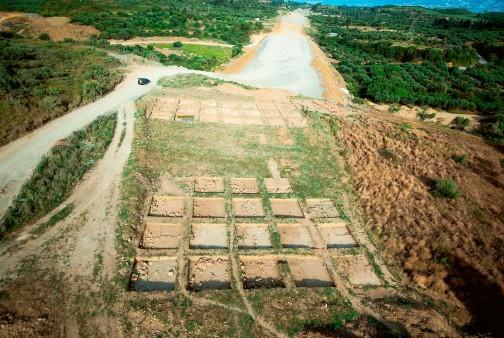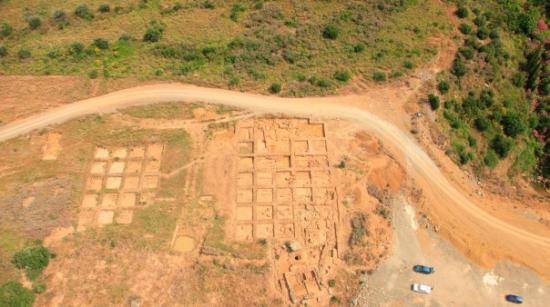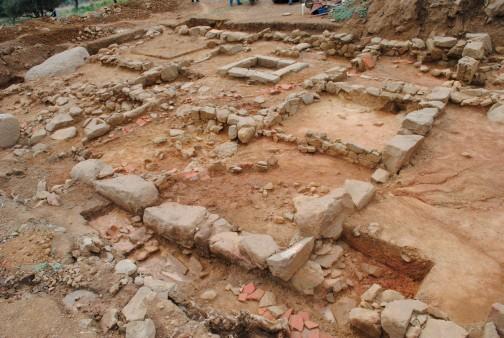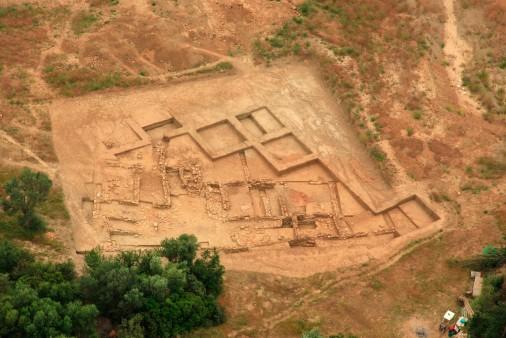Dr Olympia Vikatou , Director of the 36th Ephorate of Prehistoric and Classical Antiquities
Source - http://www.archaiologia.gr/en

Fig.1 View of excavations in the Makyneia district.
The new project of the Ionia Motorway in the district of Aetolia and Akarnania, the largest Regional Unit of the country, provided the opportunity to conduct several rescue excavations on different parts of the road axis. At the present stage the project of the Ionia Motorway consists of two sections: the section from Antirrio to Kefalovryso and from Kouvaras to Komboti. The construction of both these sections started in 2009, when the in between section was completed, the section namely described as “Broad Agrinio Bypass, section Kefalovryso-Kouvaras” (note 1). In the course of the construction of the road that runs for about 90 km through ancient Aetolia and Akarnania, 1.019 trial trenches were first dug, measuring 12,161.77 m in total length, disclosing important archaeological finds. During the last three years, rescue excavations and studies have been carried out at no less than 30 sites, while their finds cover the period from the Middle Helladic period to the first Christian centuries.
New settlements, unknown cemeteries, farmhouses and workshops, city and rural sanctuaries are included in the new data, which have already changed the archaeological map of the region. The completion of the excavations but also the investigation of areas where the preliminary trial studies have not yet been carried out, due to the pending acquisition procedures, will hopefully offer new evidence and shed more light on the history of the two ancient nations, the Aetolians and the Akarnanians, who were active in the western borders of the Greek world.
In the present article a short presentation of the excavation results will be attempted, bearing in mind that in most cases the excavation process is still going on. At present excavation research is carried out on various fronts covering a total area of 53.000 sq.m. In addition to the permanent staff of the 36th Ephorate of Classical and Prehistoric Antiquities, there is a participation of additional staff of 170 persons specializing in different activities (archaeologists, restorers, designers, technicians, workers), engaged for the excavations. Archaeological investigation within the framework of major of minor public projects is being financed, in accordance with law 3028/2002 “On the Protection of Antiquities and by and large of Cultural Heritage”, by the project owner and following approval by the central services of the Ministry of Culture and Sports.
The first section of the Ionia road passes through an area of great archaeological interest. Along the road axis, running from south to north, first we meet ancient Makyneia, followed by the Gavrolimni valley which lies between the mountains of Paliovouna and Varasova, and finally, ancient Kalydon where is located the important sanctuary of Artemis. In such an area it was therefore expected to find new archaeological sites, concerning either settlement or funerary remains. Moreover, in the same area passed in antiquity the road which beginning from Epirus went down and reached Naupaktos and the gulf of Patras, being the principal road connecting Nicopolis with Patras. That was the road which secured the communication between Aetolia and the Northwestern Greece. It seems that this road passed very closely to the Laphrion sanctuary of Kalydon, reached the western downslopes of Varasova and the Gavrolimni valley, and went up the southern slopes of Paliovouna where was the most difficult pass. It continued by going down Paliovona and then it passed by the ancient towns of Makyneia, Molykreio, Antirrio and ended at Naupaktos (note 2).
Makyneia, «Rizo» locality (fig.1)
From the beginning of the Ionia road, at the extension of the Rion-Antirrion bridge, and up to the 14th km approximately several remains have been unearthed in two areas mainly, those of Makyneia and Gavrolimni (note 3).
Extensive remains of a settlement came to light to the southwest of ancient Makyneia (note 4), in the «Rizo» locality, between two waterstreams (fig. 2).

Fig. 2. Habitation remainders in the Makyneia district.
The excavation started in the year 2009 and still goes on until today, considering that new buildings but also remains from earlier phases of the settlement in deeper layers are constantly being found. That particular excavation is one of the greatest carried out within the construction of the Ionia road. It covers an area of 32.000 sq.m, where have vome to light great parts of an unwalled settlement, which most likely was part of ancient Makyneia. The excavation works have disclosed until now roads and parts of at least 19 building complexes and also the remains of several other, fragmentary preserved, buildings and terrace walls (fig. 3).

Fig. 3. Hellenistic building in position “Rizo” of Makyneia.
The habitation is spread out on several terraces with no regular plan. From the material collected until now it appears that the area had been inhabited from the end of the 6th until the 2nd century BC, but there has been a prehistoric settlement dated in the Middle Helladic until the Late Helladic period, best represented by the late Mycenaean phase.
Among these buildings which have until now been studied, prominent position is taken by a complex dated to the Classical period and multi-spatial buildings of the Hellenistic period of the type having a central room with a hearth, a type considered as characteristic of northwestern Greece (note 5). A monumental tower made of stone bricks, built into the northeastern part of the settlement, is of particular interest. It obviously formed a fortified dwelling built at a crucial spot, considering that it overlooks the whole area. Similar towers are to be found in Attica (note 6), but also in neighbouring Aetolia.
There is a sufficient number of movable finds from the settlement and they are of particular interest. They mainly consist of decorated vases, plain vases of everyday use, various small objects, weights, loomweights, several coins, tools and so on.
Northwest of the acropolis of Makyneia, at the «Loutro» locality, in the year 2010 and while carrying out the same project, the remains of farmhouses dated to the Hellenistic and Late Roman period have been investigated. That particular locality is in the area of the tunnel exit of Makyneia, at the northwestern slope of a low hill. The ancient remains shall be considered as lying at the periphery of the ancient town. The most important of them was a large Roman farmhouse dated to the 2nd-3rd century AD (dimensions 17.80×16.80 m); it consisted of ten rooms arranged in four parallel lines. One of these rooms contained a built containing vat (note 7). The house had been built over another one dated to the Hellenistic period. The finds coming from the Roman farmhouse consist of several storage jars, a grindstone from an oil press, pestles, grinders, animal bones and a large number of movable finds made of copper and iron, and also lead weights.
Gavrolimni
The Gavrolimni valley, lying between Varasova and Paliovouna, attracted the interest of man already since the Prehistoric times and several important remains of that period have come to light. Further north of the above mentioned sites, in the Chalkeia-Gavrolimni section of the road, important prehistoric building remains of exceptional interest have been investigated. They consist of two big, wide-spaced building complexes that belong to the settlement of the Middle-Late Helladic period, which has been earlier spotted in the valley of Gavrolimni and is dated to the transition from Middle Helladic- Late Helladic to the Late Helladic IIIC period (note 8). The first complex, that of the Middle Helladic times, was clearly connected with workshop activities, as shown by the remains of two kilns, one of them round and the other one petal-shaped, which have been found within and outside the building. The complex consists of two buildings, of which the second is the larger, consisting of 11 rooms in total; it seems that is has been destroyed by fire. A large quantity of everyday use pottery has been derived from its investigation.
The second complex, that of the Late Helladic period, is the most representative of the latest Mycenaean phase and is marked by the presence of a large quantity of large storage pithoi, suggesting that it was most probably used for production or trading activities (fig. 4).

Fig. 4. Building complex of Late Helladic period in Gavrolimni.
Though the building has not been preserved in sufficiently good condition, it has been concluded that it disposed of ten rooms, while it had three construction phases. A sufficient number of pottery vases, especially of everyday use, and various small finds were found during its excavation.
At a small distance to the south, there is in progress the excavation of a large, multi-spaced building complex; It has been preserved in excellent condition and is dated to the Hellenistic period.
The earlier rescue excavation of the Ephorate of Antiquities in that area as well as the recent ones, which are here briefly mentioned, clearly show that the Gavrolimni valley is a very important archaeological site, continuously inhabited since prehistoric period, while new evidence keeps coming to light. Most important however, up to now, appears to be the prehistoric habitation following the discovery of the extensive remains of a settlement of that period.
PART.2